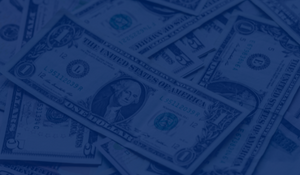International markets offer enhanced diversification in a well-balanced portfolio
The Dollar is on a Euro trip
U.S. dollars are nearly as valuable as euros today, which is a mixed blessing with major consequences.
The dollar has been getting stronger lately. Much stronger. Its recent strengthening against the euro is particularly remarkable and worth a look.
A currency’s strength refers to its value relative to other currencies. So a stronger dollar means it’s become more valuable compared to the euro.
The chart below illustrates the dollar-euro relationship over the last two years:
The blue line shows the dollar’s value starting at 85 eurocents two years ago and climbing to nearly a full euro today. This shift represents serious potential savings for Americans, as the prices we pay for products from Europe are now on par with the cost in dollars for the first time in two decades.
Consider my experience as a college student living in Italy during the spring of 2008. At that time, the exchange rate was as high as 1.5 dollars per euro. The price of a beer at my favorite bar back then was 6 euros, which I had to shell out 9 dollars to get. American students today need only 6 dollars for that same beer—what a deal!
So now might be the perfect time to take that European vacation you’ve been putting off for years. But the implications go well beyond cost savings for U.S. travelers. A stronger dollar makes European imports cheaper for Americans at home, which is a benefit to consumers who buy European goods.
While cheaper imports might sound appealing, they’re a bit of a mixed blessing. These discounts give foreign competitors a leg up against U.S. businesses on their home turf. And European consumers are also forced to pay higher prices for our exports, which can hurt American producers who rely on selling beyond our borders.
So, the net effects of the shifting exchange rate can be good or bad depending on where you sit.
What’s causing this shift? The new dynamic in the dollar-euro relationship is due to several factors that all relate to the fact that the U.S. economy is faring relatively better than Europe’s.
Europe put more restrictive and long-lasting shutdown measures in place during the pandemic, which their economy has struggled more to recover from while facing the widespread inflation that’s affecting the globe. And Russia’s invasion of Ukraine has created an energy crisis that’s further compounded European economic troubles.
The fledgling European economy has put central bankers in a tight spot. Much like our Federal Reserve, the European Central Bank is seeking to curb rampant inflation and encourage economic growth. But European policymakers have been combatting price increases less aggressively because they’ve deemed their economic recovery too fragile to sustain the impact of interest rate hikes like we’ve seen in the U.S.
The differences in approach between our Fed and the ECB have led to a relative disconnect in interest rates. Relatively higher rates of interest and better economic prospects have made investing in the U.S. more appealing than Europe.
These investments take place in U.S. currency, so international investors need to get their hands on dollars to make them. They swap their euros for dollars, which drives up the value of the dollar compared to the euro. It’s good old-fashioned supply and demand.
The result is a stronger dollar, which comes with some benefits but contains some downsides mentioned above as well. And fluctuating exchange rates in general can create uncertainty about the future and lead to economic instability. The consequences are mixed, for sure.
The big question that lingers is whether the current shift is a temporary blip or a long-lasting rebalancing of the global economy.
Stay tuned, more to come.
-1.png?width=50&name=Untitled%20design%20(32)-1.png)



